After three consecutive third-place finishes, Atalanta finished last season in eighth place.
It was the first time La Dea failed to qualify for a European competition since the 2015/16 season.
In a period that brought plenty of adulation for their quick passing, intense pressing, and high-risk possession-based approach, many people saw last season’s eighth place as a fall from grace and the end of an era.
However, it has been quite the opposite as the start of this season has seen Gian Piero Gasperini’s team make their best start to a Serie A campaign, With eight games played they have won six, drawn two and have not yet experienced defeat.
We are used to seeing Gasperini’s Atalanta aiming to keep possession aiming to play high up the pitch and looking to outscore their opponent.
Instead, we are now seeing an Atalanta team that keeps less possession makes fewer passes, takes fewer shots, and sits in a solid defensive block.
This scout report will provide a tactical analysis of Atalanta’s start to the season.
We will look at the changes made to Gian Piero Gasperini’s tactical approach, as the Italian coach has made key changes within his tactics to make Atalanta more pragmatic and more adaptable.
Formation
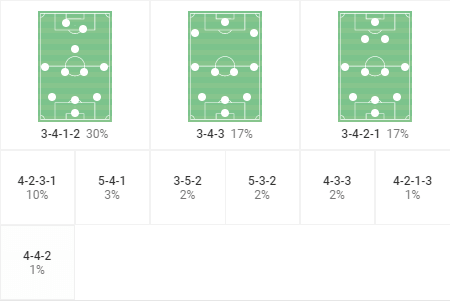
Although there have been changes to the team’s tactical approach, one thing that Gasperini hasn’t changed is his preference for a three-at-the-back formation.
The 3-4-3, 3-4-1-2 and 3-4-2-1 formations have still been the main base formations used by Atalanta this season.
These three formations provide the core for Gasperini’s philosophy and have done for most of his career.
As you can see other formations have been used situationally in different matches and for a certain period within matches.
This itself is an indication that Gasperini wants to be more adaptable, not just to the opposition but to the players that have been brought to the club in the transfer window.
Nevertheless, Atalanta will always refer to either one of the 3-4-3, 3-4-1-2 or 3-4-2-1 formations whilst Gasperini is in charge.
Changing the attacking approach
The tactical approach we have seen throughout Gasperini’s tenure at Atalanta is focused on attacking.
Playing with a high tempo in possession and defending with aggression and intensity out of possession.
Their attacking play was varied.
It was never set on a specific passing style.
They focused on attacking through the wide areas and half spaces by creating overloads and affecting them with combination play.
The team would form their wide attacks through the use of transitional play, both vertically and laterally.
These next images show examples of Atalanta generating overloads through wide areas.
Both situations show Atalanta maintaining possession and creating a 4v3 overload.
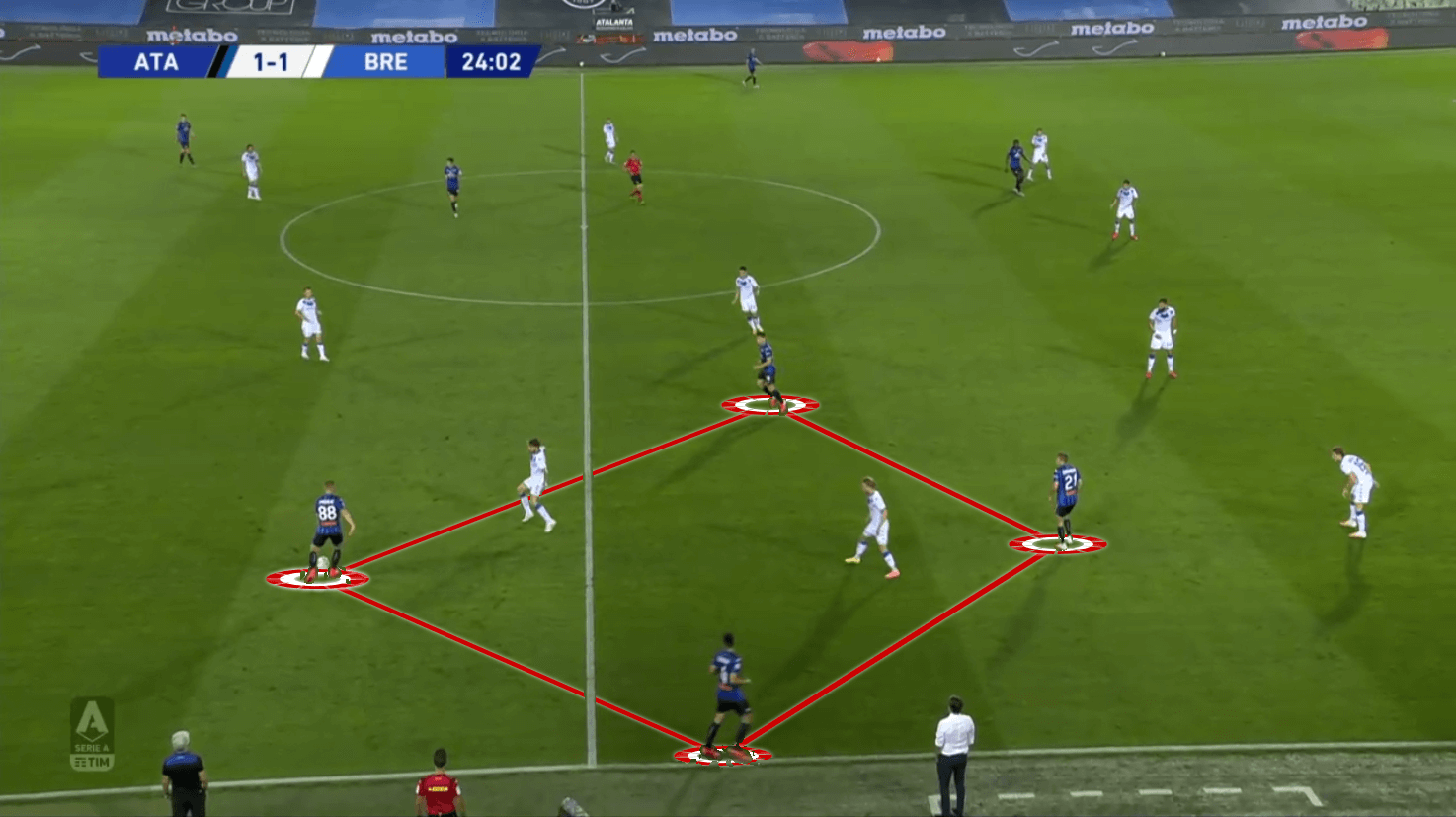
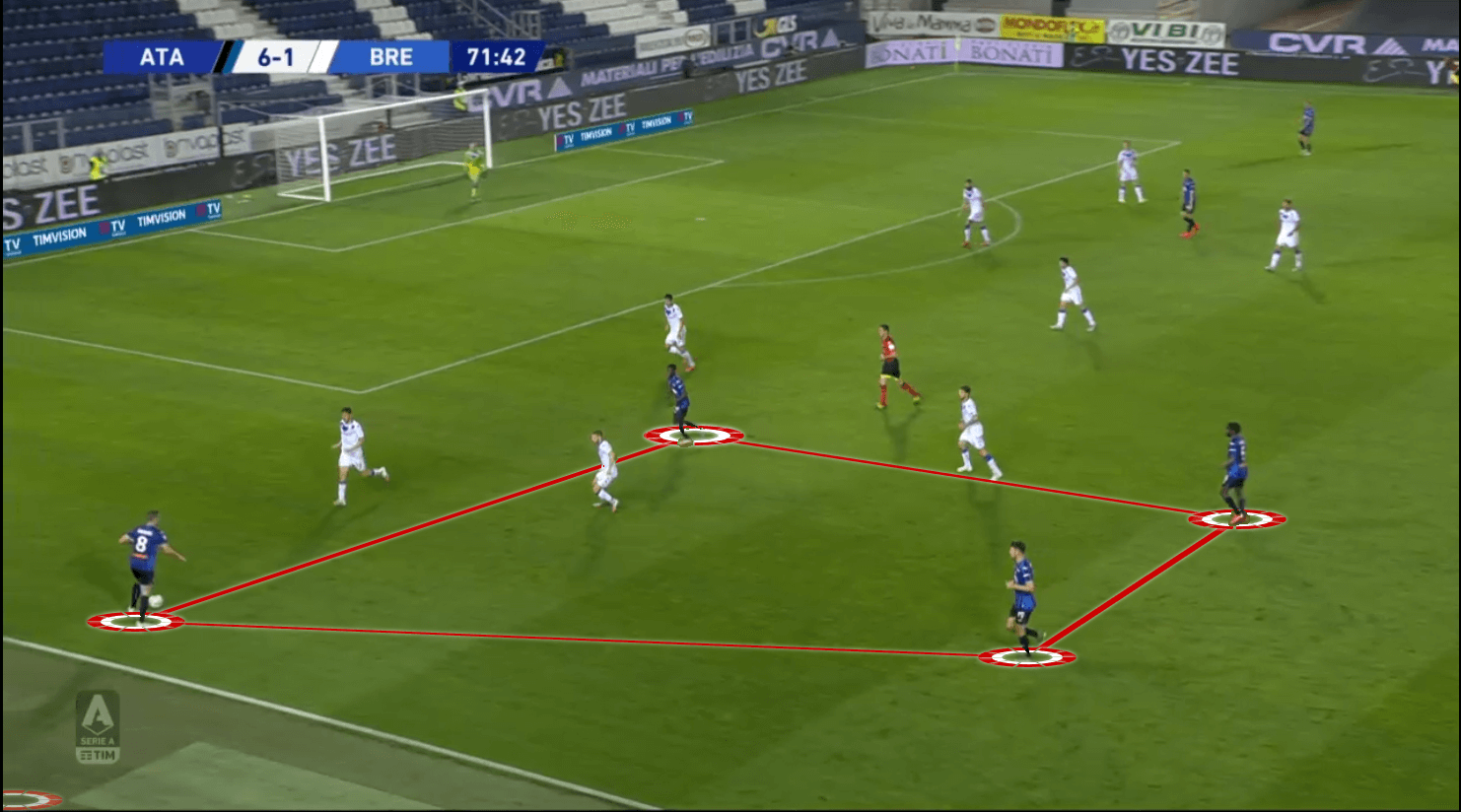
The aim was to ensure the team kept the ball more than the opponents and scored more than their opponents.
Last season Atalanta’s average possession was 53.9%.
Although it has never been the highest in Serie A it has always been towards the top end of the table.
The chart below shows the average amount of possession kept in Serie A so far this season.

Atalanta have kept possession the second least amount this season, averaging 43.50%. From an attacking perspective, this represents a substantial change in approach from Gasperini.
Atalanta is allowing their opponents to keep possession for longer periods throughout the game when they win possession or hold possession.
They are making 13.2 passes per minute, which is the fourth lowest in the league.
In comparison to last season, they were making 15.34 passes per minute.
This represents an emphasis on attacking and getting further forward quicker.
Trying to get the ball forward quicker and making longer passes represents a higher risk of losing possession.
Atalanta has made 44.65 long passes per 90 minutes so far in this campaign.
It is the fifth highest in the league and has increased from 38.81 per 90 minutes from last season
Long balls have been a key aspect of Atalanta’s new approach.
The team are still playing out from the goalkeeper during the build-up phase but instead of trying to play out through each third of the pitch vertically, their build-up approach is to attract the opposition towards the ball and then Atalanta attempt to hit it over them and directly into the attacking third.
The first images show the build-up structure Atalanta use from a goal kick.
They build up in a 3-4 structure.
Six Fiorentina players have pushed up into a high block to stop any ball progression from the build-up.
The goalkeeper does not take the goal kick, Caleb Okoli starts the play and passes to the goalkeeper, who then takes a long goal kick and doesn’t play out through the defence.
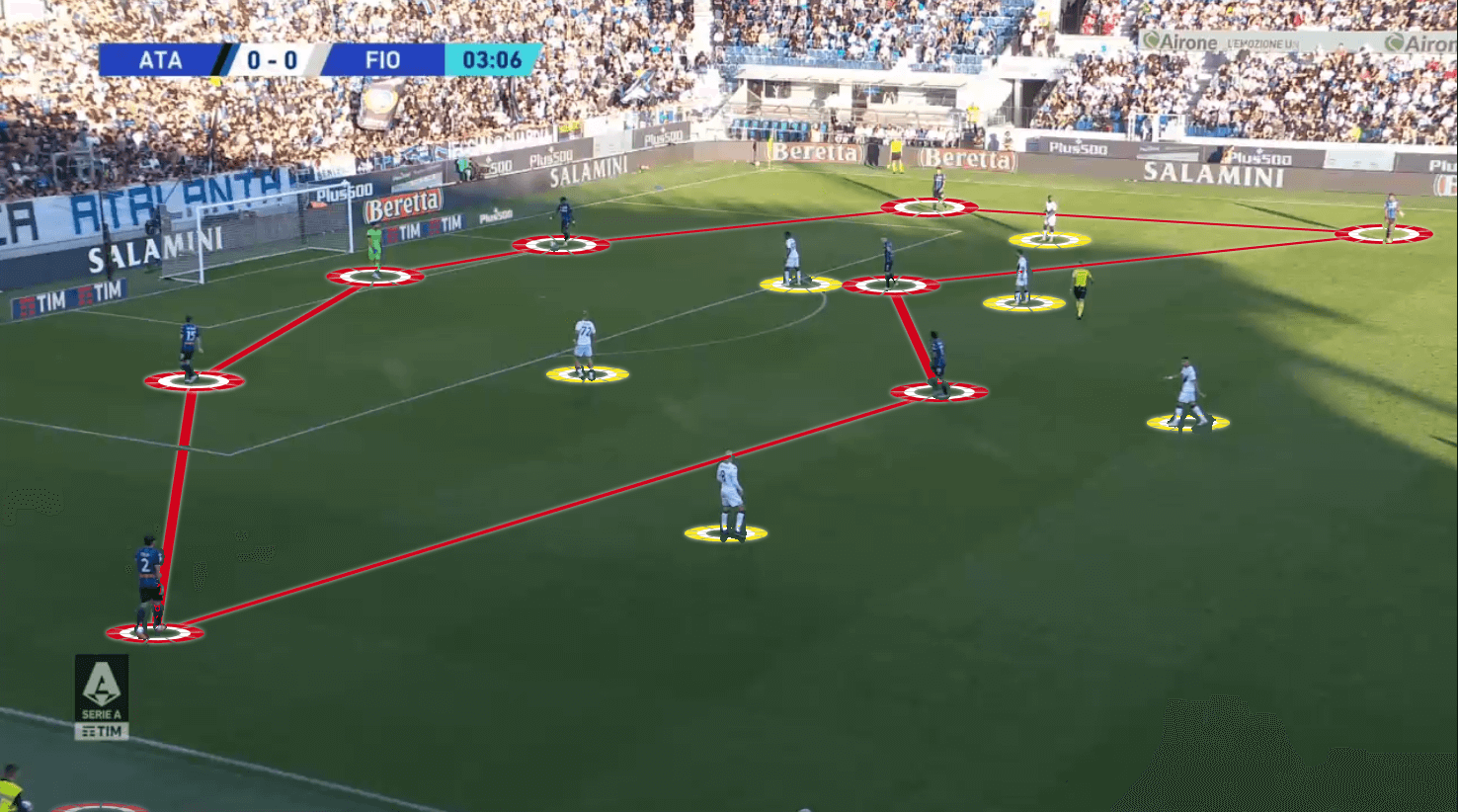
The outcome of that is the image below.
The benefit of this is the space that opens as a result of the build-up structure attracting the opposition players to push high.
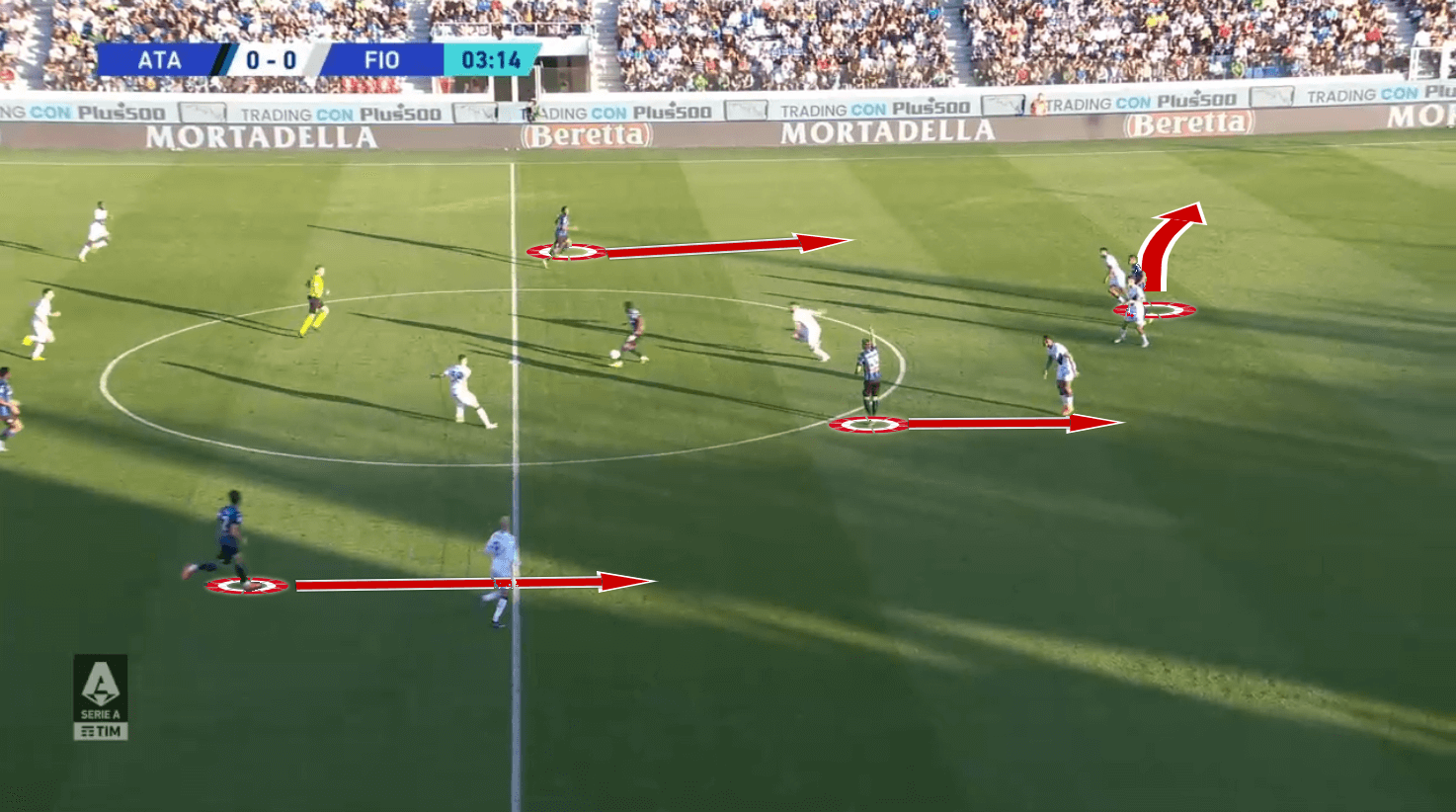
The data reflects Gasperini changing the team’s attacking approach and tactics to make the team less attacking.
Last season Atalanta was getting 24.01 touches of the ball in the penalty area per 90 minutes which was the second highest, this season they are averaging 16.51 per 90 minutes which is only the tenth highest in the league.
They are having fewer attempts on goal as they have only made 9.58 shots per 90 so far this campaign.
Defensive Shape
One of the reasons for this is that when Atalanta hasn’t got possession, a three-at-the-back formation with wingbacks enables Atalanta to transition into a five-man defence.
This then provides them with the structure to be able to switch between a 5-3-2, and a 5-2-3 defensive shape throughout a match.
Under Gasperini, Atalanta’s defensive style has been identified with high-intensity and aggressive pressing and because of the man-to-man marking tactics, they haven’t been accustomed to defending against the ball with a specific defensive shape.
Their defensive shape is usually dictated by the opposition’s attacking shape because each player man-marks all over the pitch.
This season has seen this approach adapted, the man-to-man marking approach remains a principle with Gasperini’s tactical approach, it just hasn’t been used continuously through a whole match.
It’s used occasionally depending on the situation within the match, usually during the first period of the game against specific opponents.
The example below shows Atalanta’s varied approach sitting in a 5-3-2 high defensive block.
They have condensed the space between the lines, but instead of being compact, they are defending with width.
Former Middlesbrough midfielder Maarten De Roon is about to put pressure on the ball and switch the defensive block from a 5-3-2 to a 5-2-3 as they look to stop Fiorentina during their build-up.
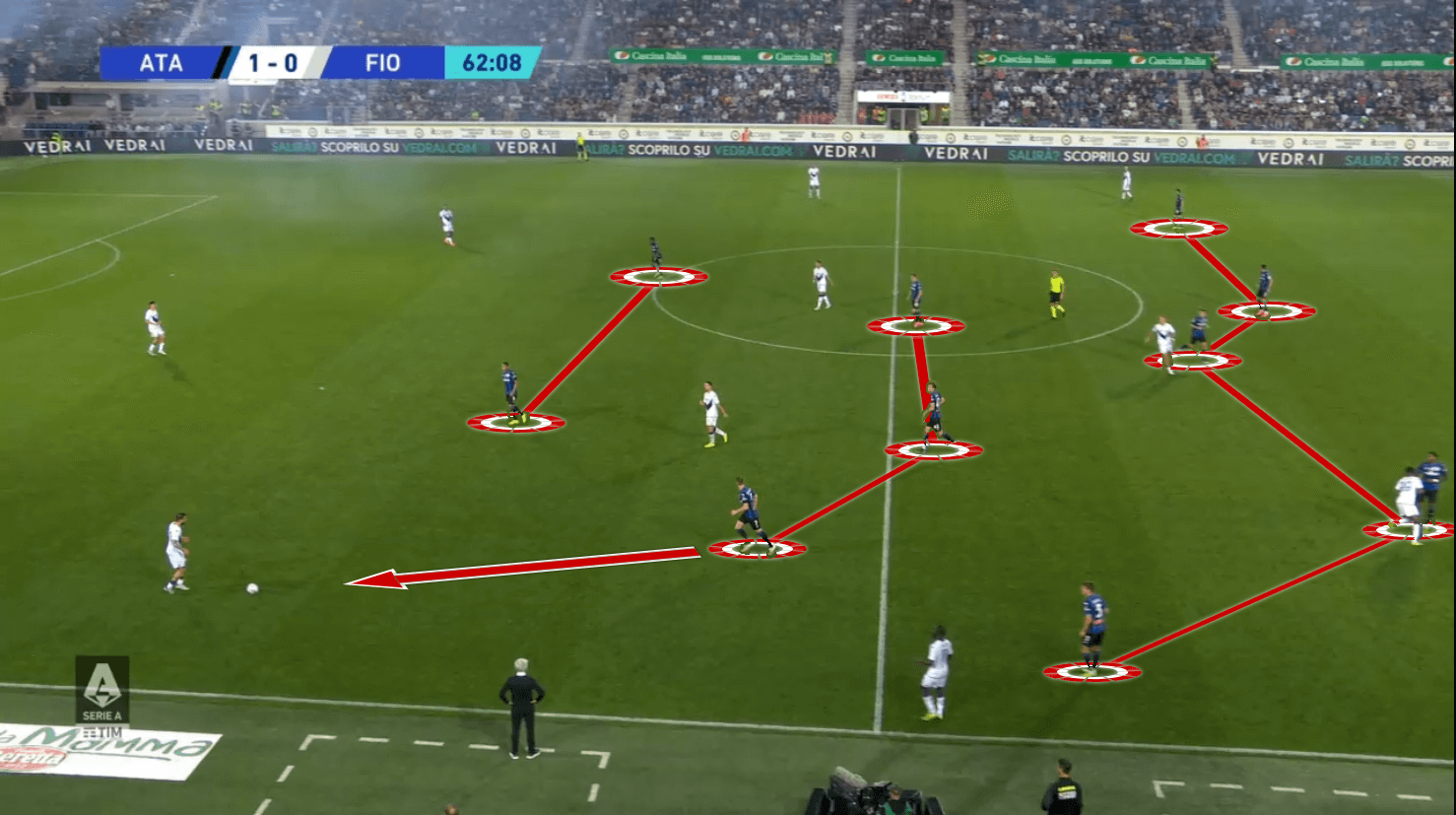
Instead of pursuing the ball aggressively, they are maintaining their shape and forcing the play into certain areas.
The purpose of this type of defensive shape is to force the opposition wide by stopping any vertical progression through the centre of the pitch and forcing the opposition out wide where they can then press immediately without shifting across.
We are seeing Atalanta attempt to keep a more solid defensive 5-3-2 defensive shape that moves together as a unit from a high block to a medium block and a low block with a man-orientated pressing system.
This image shows Fiorentina building up from the middle third of the pitch in a 3-2-5 attacking shape.
The centre-backs have been forced to play the ball wide because of the 3-2 structure Atalanta has in the centre of the pitch.
As soon as the play is forced into the wide area the 3-2 structure switches to the 2-3 structure as the central midfielder joins the attacking line to put pressure on the man in possession.
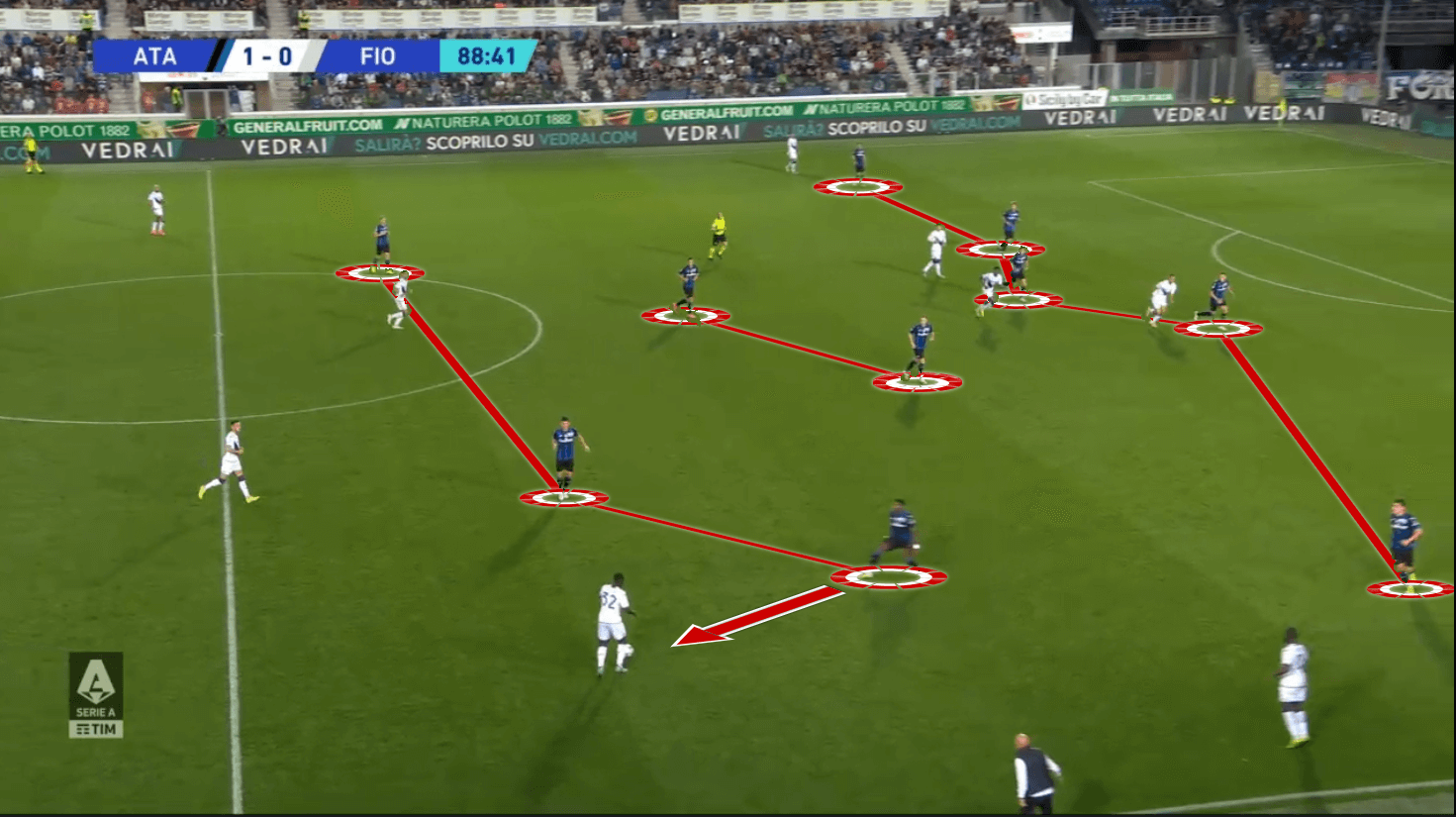
The midfielder should join the attacking line to press out wide as opposed to a centre forward pulling out because if the centre forward does, it creates space in the centre of the pitch for the opposition to exploit.
Once this happened, the chances of the midfield losing their shape increased due to the space in front of them.
Defending in a low block is something we have seen more of from Atalanta this season.
Usually, when a team’s defensive block forces the opposition out wide it’s to force the opposition further away from the goal to attack through crossing.
Atalanta forcing a team out wide is for them to win the ball in the wide areas.
This is why the defensive line defends with width instead of being compact.
They look to stop the cross and win the ball.
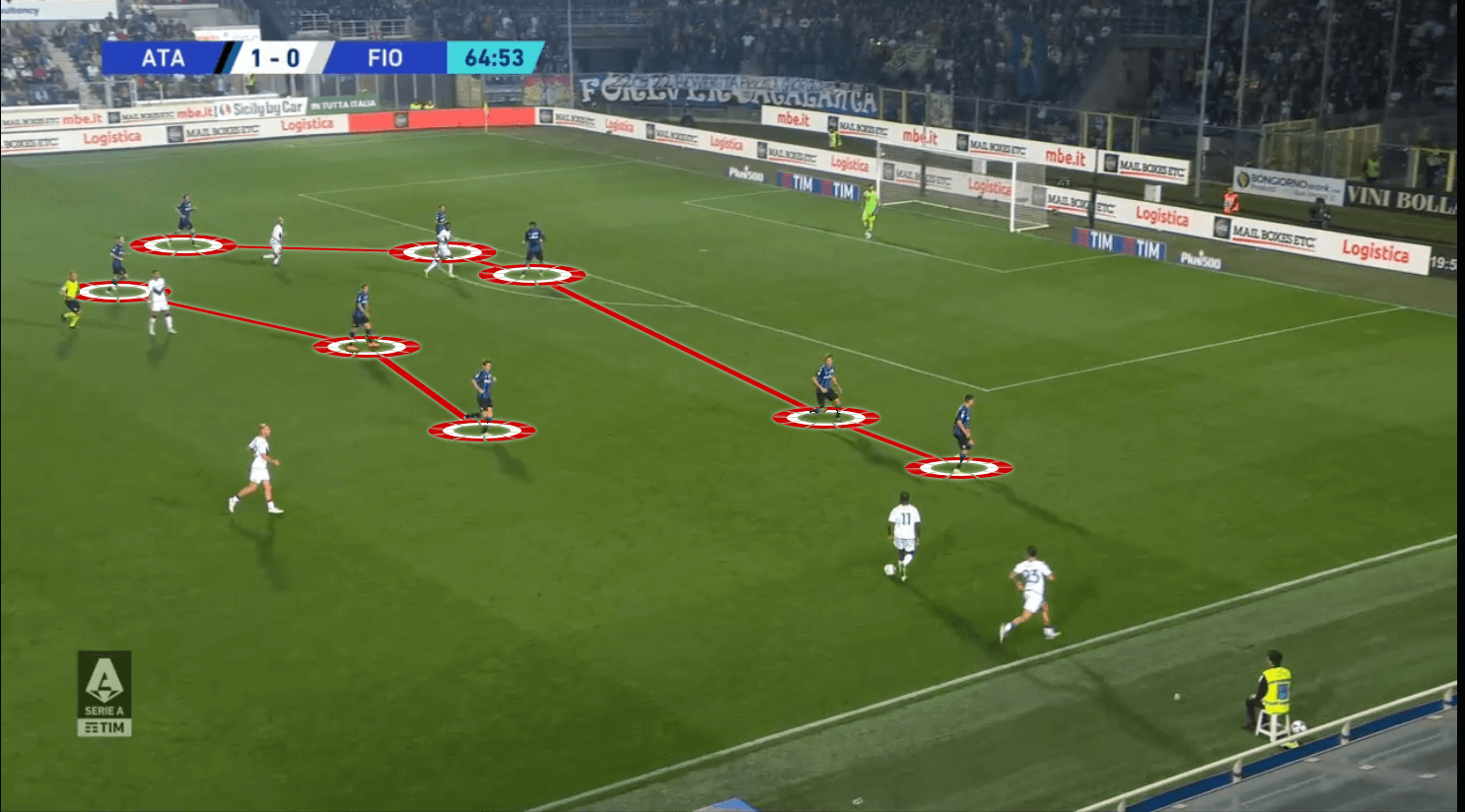
You can these tactics against Fiorentina below.
The midfielder remains central as a three.
The centre-half has pushed out wide to support the full-back, stopping the overload but to also maintain pressure on the ball.
The data analysis we have compiled shows the number of goals Atalanta has conceded this season against their expected goals against.
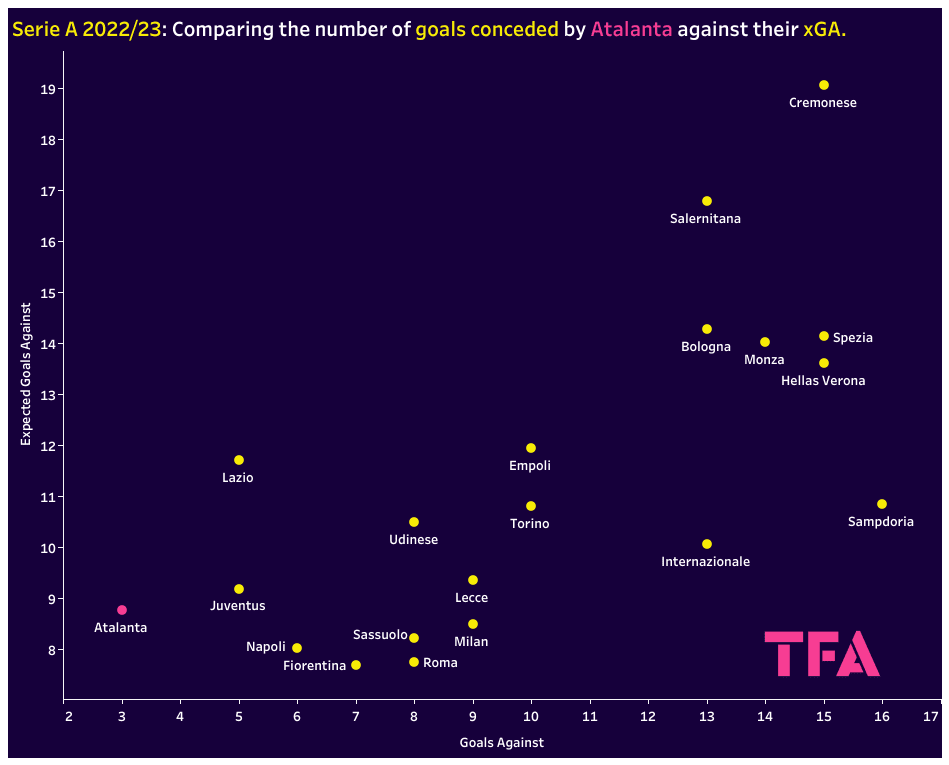
The data confirms Atalanta has conceded the least number of goals so far, only conceding 3 and their expected goals against is 8.75, which is the sixth highest.
Although it’s not sustainable for a team to keep performing on their expected goals throughout the season, the impact of this defensive approach has seen improvements in Atalanta’s defensive record.
Defending deep and defending wide can be a high-risk approach as it creates more space between each defender for the opposition to attack.
If possession is won as intended, it presents more options across the pitch for a counterattack.
More options make it harder for the opposition to prepare for them.
Counterattacks
Traditionally under Gasperini, Atalanta have ways been dangerous in a counterattacking situation, as their attack-minded approach demanded that the team counter through quick transitions once the ball was won.
However, no matter how dangerous they were, counterattacks have never played the main part in Atalanta’s tactics as much as they have this season, as their tactical approach is not as focused on keeping possession and transitional play as much as it has been in previous seasons.
The next two images show how Atalanta’s defensive shape sets up its counterattacking strategy.
Atalanta’s five-man defence is sitting in a low block defending a cross against Monza.
The three midfielders were sitting centrally in front of the defence, squeezing the space between both positional lines.
As the cross was cleared towards the wide area, you can see how Gasperini’s men have eight players behind the ball.
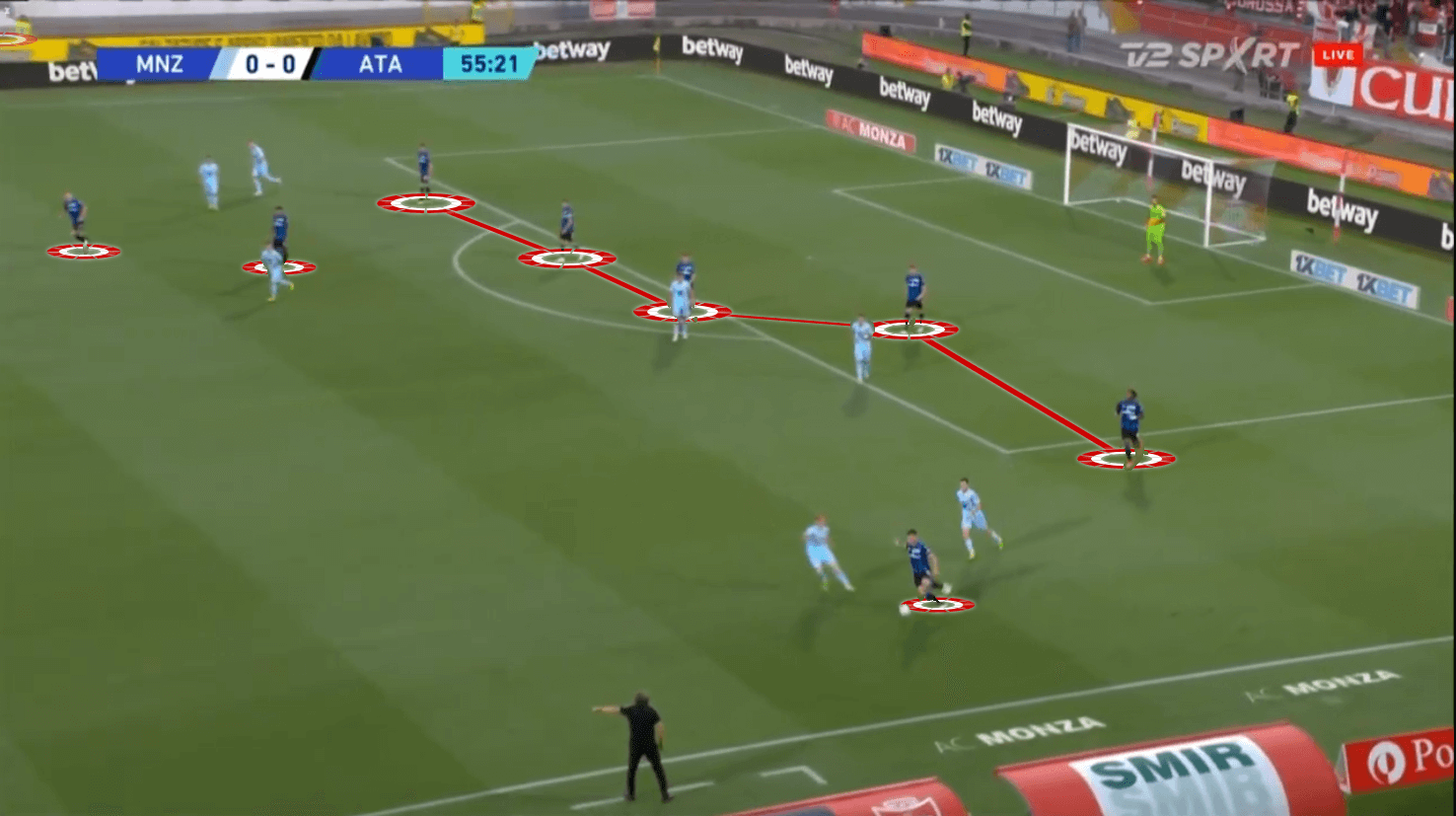
As the ball is played down the channel the passage of play develops into this.
One player drops to act as the focal point, in this counterattack it’s Ademola Lookman, and once he turns inside the counterattack starts.
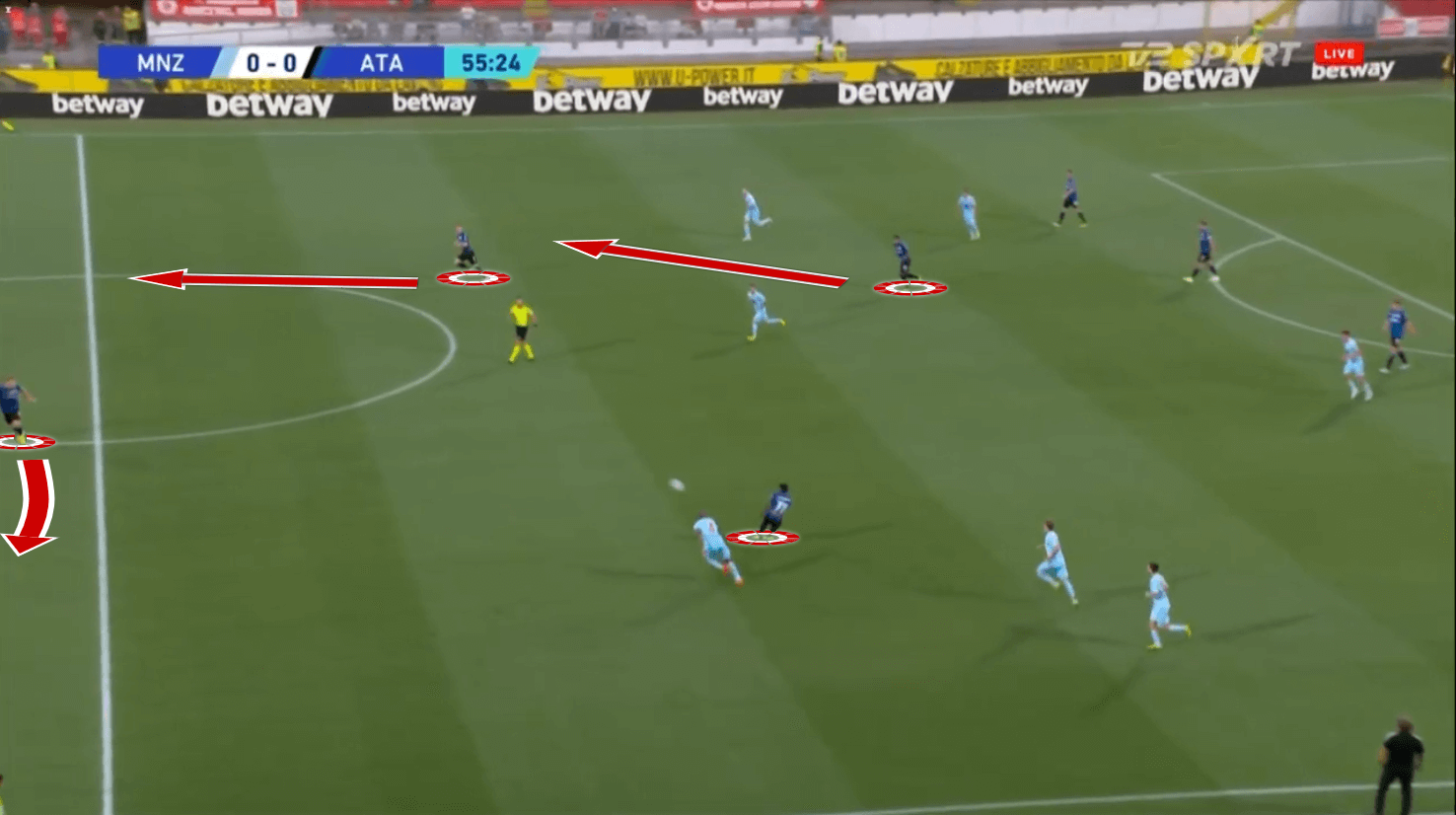
You can see the same pattern here.
It’s a similar scenario Atalanta are defending the cross which goalkeeper Marco Sportiello collects and immediately goes directly towards Atalanta’s wide area.
Ademola Lookman is the focal point once again.
He is sitting in the half-space and as soon as cuts inside, the supporting players begin their forward runs.
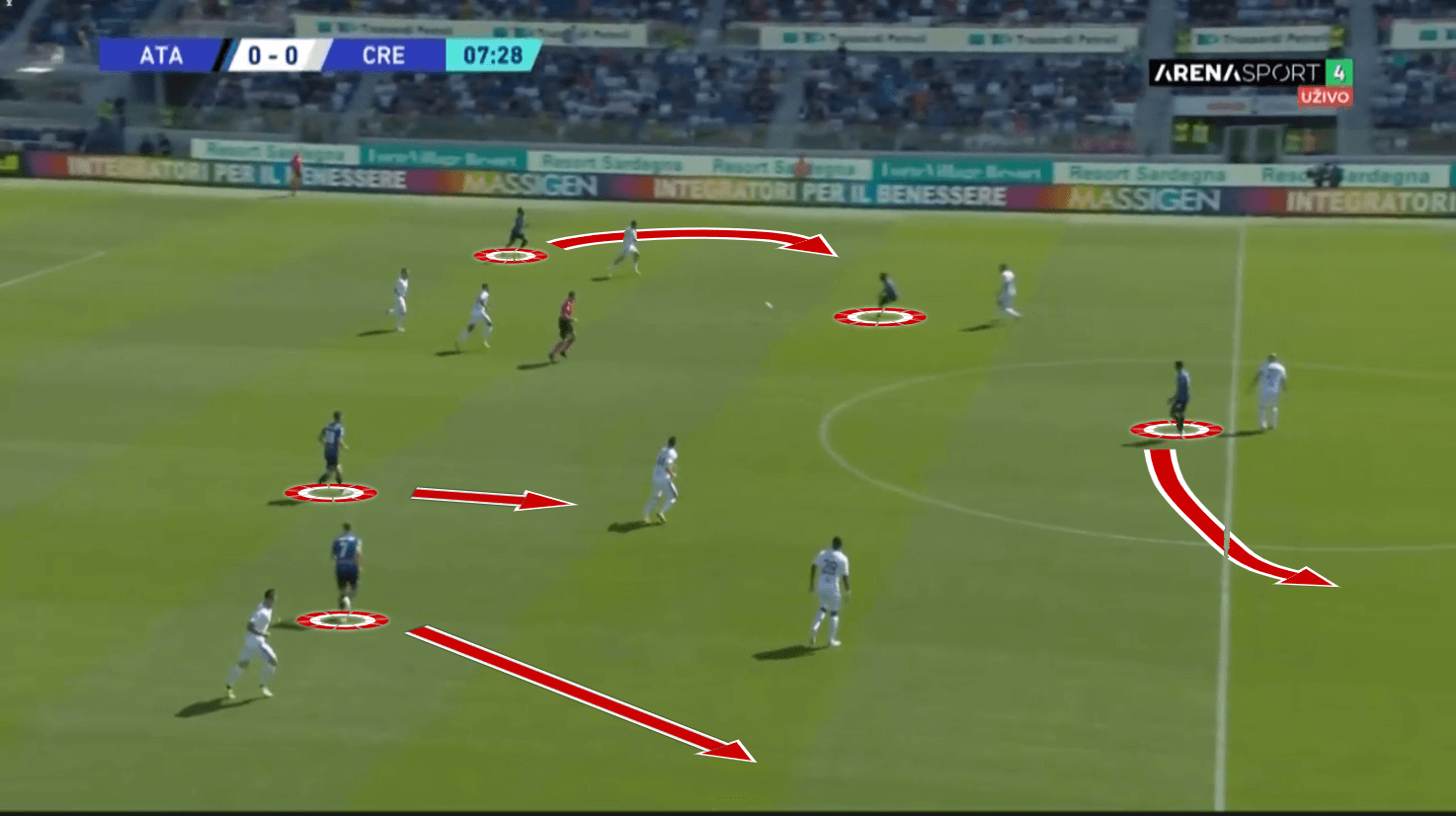
Maintaining a solid defensive block out of possession set the team up to play on the counter as the defensive shape Atalanta invites the opposition to play further up the pitch and through the wide areas.
Inevitably leaving space to attack.
As we’ve already mentioned in this analysis, attacking and exploiting the space in the wide channels and half spaces is a common tactical trait from Atalanta as it forms part of Gasperini’s philosophy, only now the team is attacking the space with direct play rather than combination play.
Conclusion
It’s so far so good for Atalanta’s new approach.
They have the best defence in Serie A and they are back in the UEFA Champions League places.
It remains to be seen whether or not Gian Piero Gasperini will keep this approach and continue with it for the duration of the season.
The changes have been made because of the need for Atalanta to stop conceding goals.
The number of goals they have conceded has stopped them from being able to go that one step further in Serie A and the Coppa Italia.
This is a tactical analysis in the form of a scout report that focuses on the changes that have been made to Atalanta’s style of play this season.
We have provided an analysis of their defensive set-up and we have looked at the tactical traits within their attacking play.






Comments